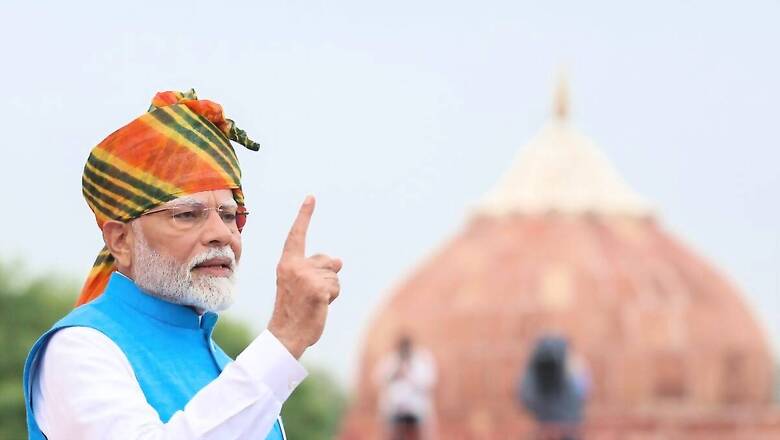
views
On October 7, 2001, Narendra Modi was sworn-in as the chief minister of Gujarat for the first time. Twenty-three years later, Modi is firmly holding the reins of the country as prime minister for the third term. While his journey from Gujarat to Delhi’s 7, Lok Kalyan Marg, is an inspiration for many, his remarkable leadership in the state allowed him to drive transformative changes till the national level.
Several schemes initiated during Modi’s tenure as chief minister have been successfully replicated across India, earning international recognition. These programmes, ranging from sanitation and infrastructure to social welfare and community participation, showcase his visionary approach. The fact that initiatives conceptualised in Gujarat were later expanded nationwide is a testament to their relevance, scalability, and adaptability, demonstrating how policies benefiting the people of Gujarat were effectively applied to the entire nation.
Sanitation: Nirmal Gujarat to Swachh Bharat Mission
Gujarat: Modi’s drive to improve sanitation also began in Gujarat, with the Nirmal Gujarat initiative, which targeted the elimination of open defecation through community-driven efforts.
Nationally: This approach laid the foundation for the nationwide Swachh Bharat Mission launched in 2014. The mission achieved 100 per cent sanitation coverage by 2019, with over 120 million toilets constructed across India, transforming the sanitation landscape in rural and urban areas.
Jal Mandir and Amrit Sarovar Initiatives
Gujarat: The Jal Mandir initiative in Gujarat led to restoration of approximately 1,200 traditional water bodies such as step wells to enhance community water supply and groundwater recharge. The project complemented the massive Narmada Canal system, which distributes water to dry regions like Kutch.
Nationally: Mission Amrit Sarovar was launched on April 24, 2022, with a mission period till August 15, 2023. At least 75 Amrit Sarovars were targeted in each rural district of all states and UTs. This is part of the Jal Jeevan Mission, which has connected more than 151 million households to tap water since 2014.
Infrastructure
Gujarat: BISAG (Bhaskaracharya Institute for Space Applications and Geoinformatics) played a key role in Gujarat’s infrastructure development during Narendra Modi’s tenure as chief minister, using geospatial technology and remote sensing for planning, resource management, and disaster preparedness. It enabled real-time project monitoring and coordination across departments.
Nationally: When Modi became prime minister, this approach was expanded under the Gati Shakti National Master Plan, integrating 16 ministries using GIS technology for national infrastructure development. Gati Shakti mirrors BISAG’s success, improving resource management, reducing delays, and promoting multimodal connectivity to enhance infrastructure execution across India.
Jyotigram Yojana to Deen Dayal Upadhyaya Gram Jyoti Yojana (DDUGJY)
Gujarat: The Jyotigram Yojana was a revolutionary rural electrification scheme that ensured 24×7 power supply to villages in Gujarat.
Nationally: The success of this scheme led to the launch of the Deen Dayal Upadhyaya Gram Jyoti Yojana in 2015. It aims to provide continuous power supply to rural India, along with strengthening sub-transmission and distribution networks.
Kanya Kelavani Yojana to Beti Bachao, Beti Padhao
Gujarat: Gujarat’s Kanya Kelavani Yojana promoted education of the girl child and addressed gender disparity in education. Annually, a drive to increase enrollment and retention of girls in schools was undertaken. Even incentives like cash benefits, free textbooks, and uniforms were provided. Modi personally led enrollment drives in villages.
Nationally: This initiative evolved into the nationwide Beti Bachao, Beti Padhao scheme, focusing on preventing female foeticide, ensuring survival, protection, and education of the girl child.
Chiranjeevi Yojana to PM Matru Vandan Yojana
Gujarat: Gujarat’s Chiranjeevi Yojana was an innovative health scheme providing free medical care to mothers and infants from BPL families. Chiranjeevi Yojana scheme proved to be an exemplary scheme in the area of public health which has contributed significantly in improving access to institutional deliveries for the marginalised section of society by reducing maternal death.
Nationally: This healthcare model was expanded under PM Matrutva Vandan Yojana to improve health-seeking behaviour amongst pregnant women and lactating mothers.
Vibrant Gujarat Summit to Make in India
Gujarat: The Vibrant Gujarat Summit was a biennial investor summit launched to attract global investment to the state.
Nationally: Taking a cue from its success, PM Modi launched the Make in India initiative at the national level to promote India as a global manufacturing hub, inviting both domestic and foreign investments.
Sabarmati Cleaning to Namami Gange
Gujarat: Sabarmati River in Ahmedabad was an integral part of the city. However, with time, untreated sewage flowed into the river through storm-water outfalls and dumping of industrial waste posed a major health and environmental hazard. When Narendra Modi became the chief minister of Gujarat, he ensured that the river was revived and a riverfront was made in the city of Ahmedabad.
Nationally: This model was replicated in the form of Namami Gange, an ambitious project for the cleaning and conservation of the Ganga River, focusing on ecological rejuvenation and sustainable practices.
Krishi Mahotsav to Pradhan Mantri Kisan Samman Nidhi
Gujarat: Krushi Mahotsav 2005 was first started in 2005-06 to bring modern implements, agricultural methods, water harvesting and electricity-harvesting programmes to the farmers at the village level through public participation in the agricultural sector in the state.
Nationally: On a larger scale, this initiative inspired the launch of many schemes like Pradhan Mantri Kisan Samman Nidhi, Beej Se Bazar, Agricultural Infrastructure Fund, Per Drop More Crop and other schemes of agriculture.
Khel Mahakumbh to Khelo India
Gujarat: Khel Mahakumbh was started in 2010 by then chief minister Narendra Modi. The annual event has played a key role in developing a sports culture and ecosystem in Gujarat. A total of 16.5 lakh people took part in the first event held in 2010.
Nationally: The same was replicated at the national level in the form of Khelo India.
Sujalam Sufalam Yojana to Krishi Sinchai Yojana
Gujarat: The Sujalam Sufalam Yojana aimed at conserving water resources and rejuvenating water bodies across Gujarat. Under the comprehensive water-conservation scheme, check dams were constructed and rainwater harvesting was promoted, significantly improving groundwater levels in the state.
Nationally: Jal Shakti Abhiyan (2019) and Atal Bhujal Yojana: The goal of Atal Bhujal Yojana (Atal Jal) is to demonstrate community led sustainable ground-water management. The major objective of the scheme is to improve the management of groundwater resources in select water-stressed areas in identified states.
Mission Karmayogi
Gujarat: In 2004, the Gujarat government decided to focus on how to streamline senior babus, freeing them of social evils. In view of the same, the Karmayogi training course was designed. The aim was to bring about a “qualitative change, fundamentally reform and improve work culture of the officials”.
Nationally: Mission Karmayogi was launched in 2020 with the objective of enhancing governance through civil service capacity- building. The example of Gujarat was taken and expanded to the country.
Monetising Solar Energy
Gujarat: Launched in 2010, the strategy has made significant progress as under the rent-a-roof project, residents give their rooftops on hire to private solar energy companies who, in turn, pay them Rs 3 for every unit of energy produced. Similarly, rooftops of government buildings like schools and hospitals are also leased out for solar panels.
Nationally: On February 29, 2024, to increase the share of solar rooftop capacity and empower residential households to generate their own electricity, PM Surya Ghar Bijli Yojana was launched. Excess electricity generated can be sold to discoms. This was similar to the Gujarat scheme.
Climate Mission
Gujarat: The Gujarat Climate Change Department (2009) was established as India’s first dedicated climate change wing. It developed the Gujarat State Action Plan on Climate Change. Under CM Modi, climate-resilient agricultural practices were adopted.
Nationally: Comprehensive national strategy to combat climate change was introduced. Ambitious targets were set for reducing carbon intensity and increasing forest cover. India successfully reduced the emission intensity vis-à-vis its GDP by 33 per cent between 2005 and 2019, thus achieving the initial NDC target for 2030, 11 years ahead of the scheduled time.
Soil Health Card
Gujarat: Gujarat was the first state to issue the Soil Health Card to farmers. Farmer can verify the specimen through scientists who examine the mineral composition in the soil. Based on the report, they provide the fertilizer with appropriate mineral percentage. This helped in soil enrichment and also reduced the erosion of the land. Gujarat’s farmers who used to grow 1-2 crops can now grow 3-4 with increase in profit.
Nationally: The scheme was implemented in February 2015, with the card providing information to farmers on soil nutrients, status of their soil and recommendation on appropriate dosage of nutrients.
Responding to Crisis: Helping All, Leaving None
Gujarat: During the 2013 Uttarakhand floods, the Gujarat government under Modi helped with the rescue and relief mission.
Nationally: In all disasters or rescue missions across the world, India has been the first responder. With Operation Ganga, India not only managed to rescue its students but also helped those from other countries.
Gujarat Skill Development Mission to Skill India Mission
Gujarat: The Gujarat Skill Development Mission (GSDM) was launched in February 2009 for coordinating state-level strategy and programmes that would generate employment.
Nationally: The National Skill Development Mission (NSDM) was launched on July 15, 2015 by PM Modi to create a convergence across sectors and states for skill-training activities.
Interacting with Students to Pariksha Par Charcha
Gujarat: As chief minister, Modi would often interact with students and teachers across the state, motivating them to work hard. In 2012, he interacted with nearly one crore students and teachers.
Nationally: Now, PM Modi speaks to students, teachers and even parents through Pariksha Pe Charcha.
E-Governance
Gujarat: The e-Gram Vishwagram Project (2003) connected villages through broadband for improved governance. It provided e-services to rural areas, enhancing transparency and efficiency, and became a model for rural e-governance initiatives.
Nationally: Digital India was launched in 2015 through which the Ministry of Panchayati Raj is implementing e- Panchayat Mission Mode Project. The aim is to revamp the functioning of panchayats and make them more transparent, accountable and effective. The ministry has launched eGramSwaraj, an accounting application, to simplify panchayat work like planning, accounting and budgeting. The ministry has also integrated eGramSwaraj with Public Financial Management System (PFMS) for gram panchayats (GPs) to make real-time payments to vendors/service providers. Till date, more than 95 per cent villages have access to internet. PM Modi has always believed in strengthening grassroots democracy.
Mukhyamantri Gruh Yojana to PM Awas
Gujarat: The Mukhya Mantri GRUH Yojana (MMGY) was announced on July 18, 2013, to make urban areas slum-free and provide housing at affordable prices to urban families from Economically Weaker Section (EWS), Lower Income Group (LIG) and Middle Income Group (MIG).
Nationally: In May 2014, it was the vision of PM Modi and the unflinching commitment of the government to build and provide pucca houses to change the living conditions of poor people in both rural and urban areas. This culminated in the launch of Pradhan Mantri Awas Yojana– Urban (2015) and Gramin (2016). Till date, four crore houses have been sanctioned under the scheme.
Swajal Dhara to Har Ghar Jal
Gujarat: The Swajal Dhara scheme focused on ensuring community participation in managing rural water supply systems, emphasising the importance of clean and accessible drinking water for all. This initiative laid the groundwork for the national-level Har Ghar Jal mission, launched under the Jal Jeevan Mission.
Nationally: Har Ghar Jal aims to provide piped water supply to every household in rural India by 2024, ensuring sustainable water management and improving the quality of life. Both schemes highlight Modi’s commitment to ensuring access to safe drinking water through people-centric, scalable programmes.
Mukhya Mantri Amrutam Yojana (2012) to Pradhan Mantri Jan Arogya Yojana (PMJAY)
Gujarat: As the then chief minister of Gujarat, Modi had started the ‘Mukhyamantri Amrutam’ scheme in 2012 to shield poor citizens from the catastrophic costs of medical treatment and illness. In the year 2014, ‘MA’ Yojana was extended to cover families with an annual income limit of Rs 4 lakh. The scheme was further extended to several other groups as well and later rebranded as Mukhyamantri Amrutam Vatsalya (MAV) Yojana.
Nationally: Drawing from the experience of the success of this scheme, the prime minister launched the Ayushman Bharat Pradhan Mantri Jan Arogya Yojana (AB-PMJAY) in 2018 — the largest health insurance scheme in the world providing coverage of up to Rs 5 lakh per family per year for primary, secondary and tertiary care hospitalisation without any cap on the family size and age. With the launch of the AB-PMJAY, Gujarat integrated MA/MAV Yojana with the AB-PM-JAY scheme in 2019 and the beneficiaries under MA/MAV and AB-PMJAY became eligible for co-branded PMJAY-MA cards.
SWAGAT to PRAGATI
Gujarat: SWAGAT was started by Modi in 2003 as the first-of-its-kind tech-based grievance redressal programme in the country. It reflected an early realisation on Modi’s part of the potential of technology to solve people’s problems. The uniqueness of SWAGAT is that it helps the common man air their grievances directly to the chief minister. It enhances ease of living by ensuring grievance redressal in a quick, efficient and time-bound manner.
Nationally: This approach was later expanded nationally with the launch of PRAGATI (Pro-Active Governance and Timely Implementation) — a multi-purpose, multi-modal platform that allows the prime minister to interact directly with central and state government officials to review the progress of critical infrastructure and public-welfare projects, as well as address public grievances.
The transition from SWAGAT to PRAGATI demonstrates PM Modi’s commitment to enhancing governance efficiency, transparency, and accountability, using technology to bridge the gap between citizens and government on both the state and national levels.
From Van Mahotsav to Ek Ped Maa Ke Naam
Gujarat: Gujarat’s Van Mahotsav, initiated by Modi, ignited a movement for environmental conservation, urging citizens to actively participate in nurturing a greener planet. The initiative encourages tree planting and raises awareness about the crucial role forests play in our ecosystem. A notable highlight of the campaign is its unique invitation for families to plant five trees for every girl child’s birth, celebrating her arrival while promoting gender equality and environmental stewardship.
Nationally: Building on this momentum, the Ek Ped Maa Ke Naam campaign emerged as a heartfelt gesture that strengthens maternal bonds and fosters environmental sustainability. This initiative has achieved remarkable success across the country, resulting in the planting of 80 crore seedlings. Additionally, Mission LiFE (Lifestyle for Environment), launched by Prime Minister Modi at COP26, encourages individuals and communities to adopt sustainable practices to combat climate change, promoting environmentally conscious lifestyles and collective action for a greener planet.




















Comments
0 comment